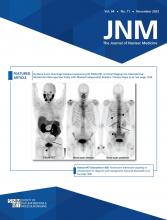TO THE EDITOR: We would like to comment on the letter from Seban et al. to the editor of The Journal of Nuclear Medicine in the July issue (1).
The results from the DESTINY-Breast04 trial, receiving a standing ovation during the presidential symposium at the annual conference of the American Society of Clinical Oncology in June 2022, have had a practice-changing impact on oncologists’ views on the role of human epidermal growth factor receptor 2 (HER2) as a therapy-predictive biomarker. Not only have promising treatment results with trastuzumab deruxtecan (Enhertu; Daiichi Sankyo Company, Limited) been found for HER2-low breast cancer, but even patients with HER2-low gastroesophageal cancer and uterine carcinosarcoma have been demonstrated to derive a clinical benefit from treatment with this drug (2,3).
Several challenges exist in identifying patients with HER2-low metastatic breast cancer who benefit from treatment with a HER2 antibody–drug conjugate, related to both pathologic reporting (4,5) and a deepened understanding of disease heterogeneity (6). This has profound implications, as selection for trastuzumab deruxtecan (or, in the future, other HER2 antibody–drug conjugates) is based on the results from tumor biopsies from single metastatic lesions. Performing repeated biopsies, especially from sanctuary sites such as the lungs or central nervous system, is burdensome for patients and not always technically and logistically feasible.
We fully agree with the authors that HER2 PET imaging holds great promise for the molecular characterization, treatment planning, and biologic understanding of HER2-low breast cancer. Therefore, we initiated a pilot study to investigate the potential of PET/CT imaging with the Affibody (Affibody AB)-based tracer [68Ga]Ga-ABY-025 in patients with HER2-low metastatic breast cancer. This proof-of-concept investigator-initiated trial is part of the larger basket trial “Phase II Study of [68Ga]Ga-ABY-025 PET for Noninvasive Quantification of HER2-Status in Solid Tumors,” which is registered at Clinicaltrials.gov with number NCT05619016 and has been approved by the Swedish Medical Product Agency and Ethical Review Authority.
Ten patients with previously biopsy-confirmed HER2-low metastatic breast cancer were included in this pilot study, and all underwent HER2 PET with [68Ga]Ga-ABY-025 followed by a tumor biopsy, with the biopsy site being guided by the results from the PET images. The results of our study are currently being analyzed, and independent reviews of both the PET images and the study biopsy samples by nuclear medicine physicians and pathologists, respectively, are ongoing. Preliminary conclusions reveal that the technique is feasible, with [68Ga]Ga-ABY-025–avid lesions in all patients with HER2-low metastatic breast cancer, and without any new safety concerns. Interesting signals relating to disease heterogeneity have been noted, as well as hypothesis-generating findings that will provide the basis for a prospective phase II clinical trial that our group is currently planning.
In conclusion, HER2-low breast cancer is, as Seban et al. stated, a clinically relevant entity for which molecular imaging with HER2 PET potentially provides a precision medicine tool that enables a minimally invasive, real-time, whole-body assessment of the presence of the target of treatment. Expansion of molecular imaging trials to other tumor types with HER2-low status (e.g., gastroesophageal and uterine carcinosarcoma), as well as with tracers representing other disease characteristics that are used for treatment selection (i.e., programmed death ligand 1), holds great promise for further clinical implementation of molecular imaging strategies.
Renske Altena*, Siri af Buréen, Thuy Tran, Rimma Axelsson
*Karolinska University Hospital Stockholm, Sweden
E-mail: renske.altena{at}ki.se
Footnotes
Published online Sep. 14, 2023.
- © 2023 by the Society of Nuclear Medicine and Molecular Imaging.
- Revision received June 1, 2023.
- Accepted for publication June 20, 2023.







